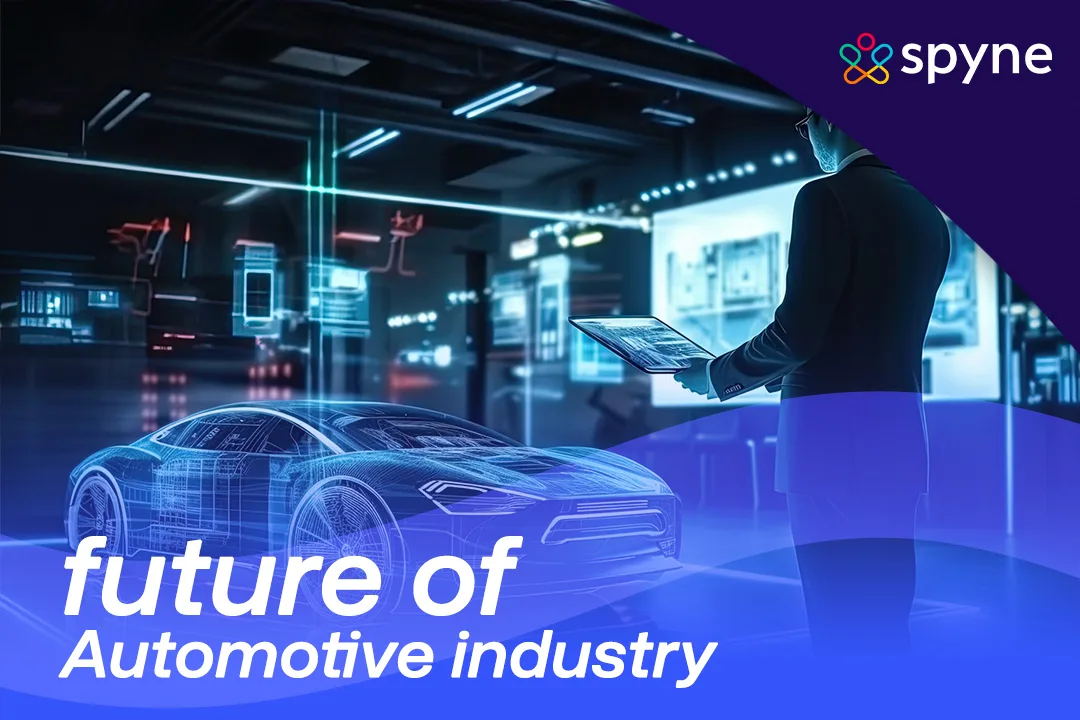Change is the only constant in the auto industry, and today, it’s happening faster than ever. From the massive takeover of electric vehicles to innovations like digitized sales of autonomous driving cars, we will witness many changes going forward. Once such change is the changing role of car dealerships. Once the backbone of car sales, dealerships’ role is also changing. With the rise of online, car buying is a major force, with digital-first experiences becoming a key driver. In fact, according to a recent report, up to 70% of consumers say they will do most or all of their vehicle purchase process online in the future. With that being said, the choice is clear for dealerships today: either evolve with the times or risk falling behind. Let’s uncover the future of automotive industry, new trends, challenges and what role dealerships will play in the coming years.
Emerging Opportunities in the Automotive Sector
The automotive industry is constantly revolutionizing. Vehicle manufacturers are introducing future car technologies, automotive design trends 2030, and features every year. Based on recent developments and trends, we have a few potential trends shaping the future of automotive industry in the world that we can expect to inspect in 2025. As car buyers look for environment-friendly options, there will be an increasing growth in hybrid and electric vehicles. Therefore, because of the huge demand for electric vehicles, we will get to see affordable and accessible hybrid and electric vehicles. Additionally, the battery in future automotive technology would be more advanced for faster charging times and longer driving ranges. We have mentioned some possible trends in the auto futures below:
1) Electric and Hybrid vehicles
By keeping the impact of fossil fuels on the environment, there would be a growth in electric and hybrid vehicles. As there is an increasing demand for electric and hybrid vehicles because them being eco-friendly transports, more car manufacturers will release new models to fulfill their consumer’s demands. Increasing the supply of electric and hybrid vehicles from numerous automotive manufacturers will allow consumers to choose from the various options. Therefore, it will make the selection of vehicles as per their needs and requirements easier for a better future of automotive industry.
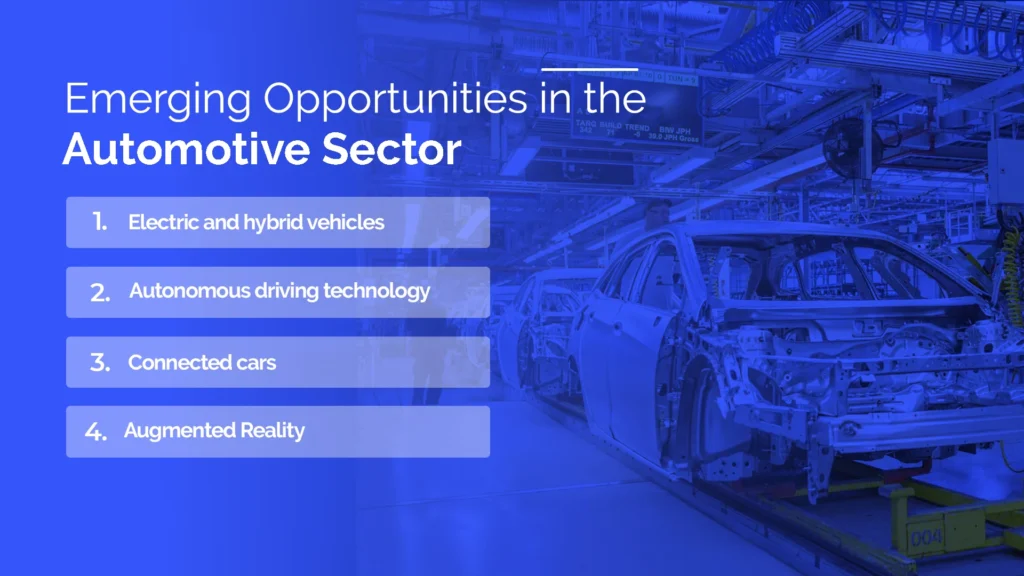
2) Autonomous driving technology
It is also known as self-driving technology. Autonomous driving technology is rapidly developing in the automotive factory of the future. It aims to enable the vehicles to self-drive without any human input. Therefore, it allows to optimize and utilize the combination of cameras, sensors, and advanced computerized automotive system integration. Additionally, most of the cars are expected to develop (ADAS) advanced driver assistance systems and self-driving features in them. While the technology improves and makes itself more advanced, it will become more accessible and widely available to car buyers.
3) Connected cars
This feature allow cars to interact with other vehicles, devices, and infrastructures. They are equipped with a variety of sensors, internet connectivity, and communication technology. Therefore, it unlocks new possibilities of convenience, safety, and efficiency in the future of automotive repair industry. To allow drivers and passengers to access features and a range of services with their cars, manufacturers build more in-vehicle connectivity, the future of technology in the automotive industry, features such as Bluetooth, Wi-FI, and 5G.
4) Augmented reality
To enhance the driving experience of car owners, manufacturers are building and experimenting with augmented reality features. It includes features like a virtual assistant and heads-up displays. Therefore, this trend will continue to grow, to provide a smooth experience for drivers.
What will be the Future of Automotive Industry?
We often think, what does the future of the automotive industry look like?
The automotive industry will shift its gears in upcoming times. The future of the automotive industry will allow car buyers to observe hydrogen fuel cells, fully electric engines, and autonomous driving. Automobile manufacturers will focus on creating specialized vehicles for specific individual needs and their imagined car designs. Additionally, individuals’ preferences are shifting to self-driving cars and electric vehicles. Whereas, some of them are looking for more convenient and affordable options to rent a car for specific needs instead of owning one.
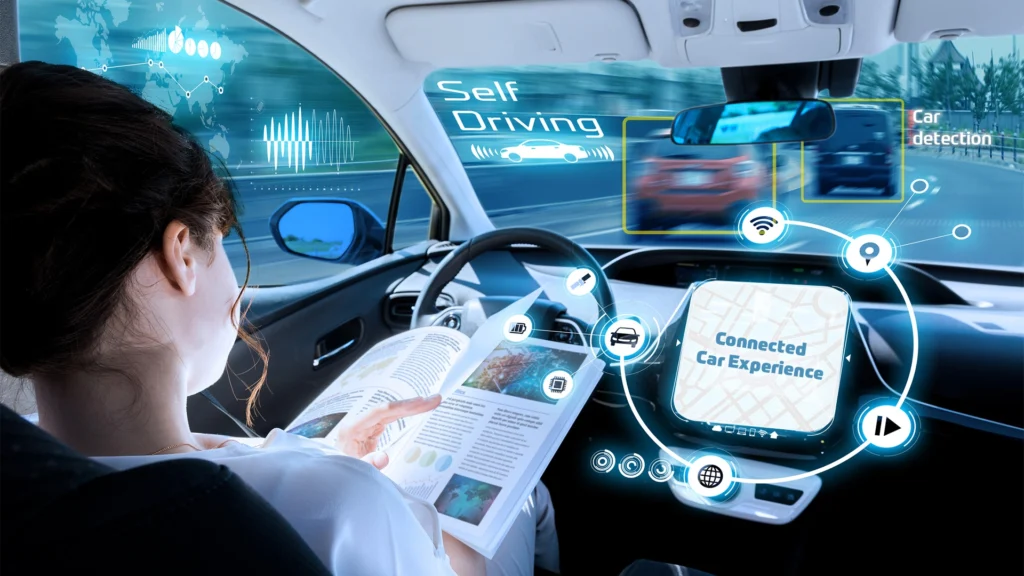
Car Manufacturers will install music apps that will allow users to connect their phones to their cars so they can commute time more efficiently. It will allow them to check emails, make calls, work with the passengers, work on the presentations inside the vehicles for entertainment purposes, and more. Additionally, they will also focus on the preventive maintenance of the vehicle which will warn the drivers about the potential faults in the car.
Top 5 Trends in the Future of Automotive Industry
The automotive industry is considered one of the largest, most prestigious, and influential markets worldwide. Whereas, the industry has remained stable over the past few decades. However, it will bring some changes and future trends in the automobile industry to shake up the market. We will get to see environmental innovations and rapid technologies to tackle new challenges. Therefore, we have mentioned some top future automotive industry trends below:
1) Autonomous driving
Autonomous driving technology is continuously revolutionizing. Although you probably won’t see self-driving cars on every road everywhere you go. However, we can expect ADAS to range from simple features like parking sensors to more complex ones like adaptive cruise control that automatically adjusts speed based on traffic. Additionally, ADAS features will likely be included as a regular part of new cars.
In the future, we will get to see more autonomous vehicles with Level 3 and Level 4, that have minimal human intervention or may not require any in certain conditions. Therefore, these technologies will enhance safety and decrease car accidents.
2) Electric vehicles
Electric vehicle demand is increasing and we can expect to see a huge number of EVs on the road by the end of the year 2025. Car manufacturers understand the EVS demands and they are making them more affordable, so each individual can opt for an EV. Additionally, the government is also providing incentives for manufacturers to encourage them in the production and adoption of electric vehicles.
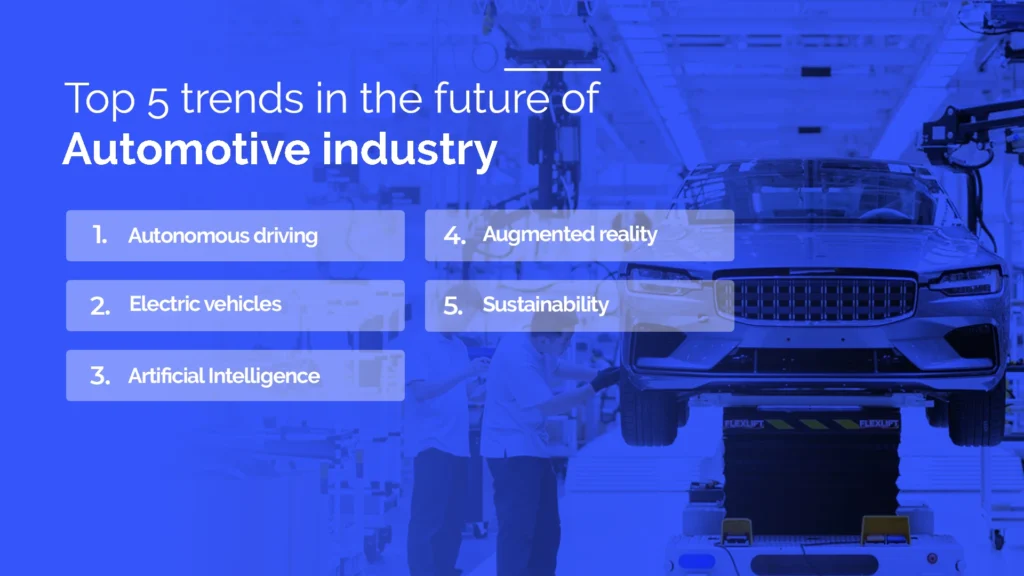
3) Artificial Intelligence
The resurgence of AI in future of automotive industry will allow car buyers to look for smarter vehicles, that have features like predictive maintenance and voice recognition. Car manufacturers can utilize Artificial Intelligence to change buyer’s preferences by offering them advanced features. AI can leverage and improve the car driving experience for vehicle owners, by letting them know of any mechanical faults before any major issue happens. Additionally, AI in automotive industry can help offer an extraordinary navigation experience and reduce fuel consumption, which ultimately improves the driving experience.
4) Augmented reality
Augmented reality cars use dashboard computers to give drivers real-time information. They overlay digital information onto the real world. Additionally, this information is displayed on the windshield or a transparent screen near the driver’s line of sight. Therefore, this can include directions, speed, and hazard warnings. It also helps drivers stay focused on the road while accessing important information and leveraging the future of automotive industry.
The system can identify objects like pedestrians or oncoming traffic and highlight them for the driver, increasing awareness and helping avoid accidents. Therefore, investment in AR technology for the global automotive industry forecast for 2025 will boost.
5) Sustainability
Car buyers are concerned about the environment which leads to an increase in demand for vehicles made from sustainable materials. To sustain in the market and give a competitive edge to the players in the future of automotive repair industry. Manufacturers need to develop strategies to create vehicles made from recycled materials.
The Automotive Industry is Expanding or Diminishing?
Ever since the pandemic, the automotive industry sales have been on a path of recovery. With new vehicle preferences and a renewed preference for practicality we will witness growth in a steady manner this year. On these lines, the US auto industry will follow this path to a cautious recovery in 2025. Building on the growth achieved in 2024, new car sales are expected to rise by 2.7%, reaching over 16 million units, something which was not achieved since 2019. This growth is fueled by many factors like falling vehicle prices and declining interest rates, making car ownership more easy and affordable.
These findings send a strong message to the market indicating that there is still strength in demand, however the market is vulnerable to market forces such as inflation, cost of borrowing, and changing consumer preferences. Demand for EVs continues to rise; sales increased 8.8% to around 1.3 million units in 2024. But the real explosion was gas-electric hybrids, which rose 36%, crossing 1.6 million units sold. It thus reveals a preference of consumers toward cheaper and fuel-efficient options at a time when economic uncertainty reigned.
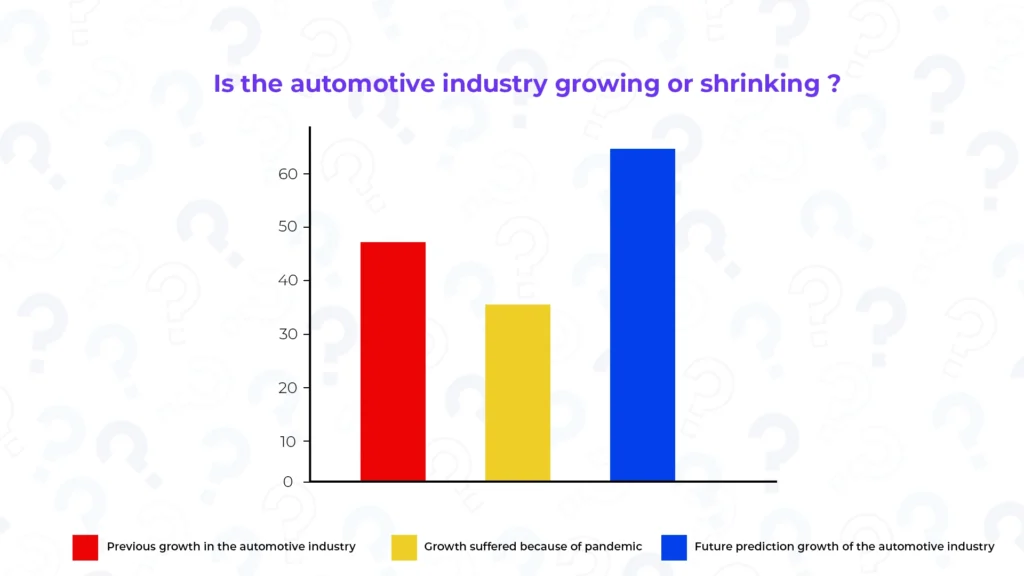
Despite these encouraging signs, the challenges remain in the future of automotive industry. Vehicle affordability is still a challenge because of the high borrowing costs and the sticker prices, which are elevated, making access difficult for most potential buyers. Although interest rates are expected to stabilize or slightly decline in 2025, the cost of car loans remains a significant burden. Therefore, several consumers will go for used cars or postpone new car purchases until the economy gets better. Besides, the industry experiences competition because automakers will be forced to alter their pricing to entice buyers and balance their profit margins.
Going forward, the US car industry both new and second hand will experience the effects of pent-up demand, improved supply chain stability, and rise of electric vehicles. Additionally, other regional factors and the country’s overall economic situations will continue to influence consumer behavior.
What are the Expectations from the Used Car Market in 2025?
The used-car market, and used automotive ecommerce market in the U.S. is likely to grow at modest rates in 2025 as it did during the previous few years. According to a recent report, the total number of sales of used vehicles in 2025 will be at around 36.5 million units. This will also marginally rise compared to the growth from last year with 2024. Retail sales are expected to account for about 19.5 million units, on the other hand, certified pre-owned vehicle sales are to be above 2.8 million units with their steady growth trend.
Affordability will be a concern for consumers. Even if interest rates level out or drop modestly in 2025, financing a used vehicle will continue to be an obstacle for most buyers. This could fuel even more demand for older, less expensive vehicles because consumers will want affordable options. In addition, leasing returns (Returns of vehicles to the dealership or leasing company at the end of their lease term) will increase the inventory levels, leading to a higher supply, which can bring the prices down. The future of used car market isn’t set for a big boom in 2025, but it’s expected to stay steady. Consumer demand remains strong, financing trends are evolving, and digital platforms are becoming the go-to for buying and selling pre-owned cars in the future of automotive industry.
Retail sales are projected to reach around 19.5 million units, with certified pre-owned vehicle sales crossing 2.8 million—continuing their steady upward climb. Affordability will continue to be a problem for the used car market, though. Even when interest rates level out or go slightly down, many buyers still won’t have an easy time financing their used car purchases. As a result, more people are likely to prioritize practicality over luxury, opting for older, budget-friendly vehicles that better fit their wallets.
On the positive side, the lease returns are going to bounce back, pushing more cars in the market. This will make the inventory on some of those segments balance off the prices. It will give little relief to some cost-conscious buyers.
1) Role of Dealerships in the Evolving Automotive Landscape
The automotive landscape in the U.S. has changed over the years from facing the slump of the pandemic to new cars entering the market and changing buyer needs. This calls for change in the way dealerships operate. What earlier was a stand-in space of vehicles for sale is now looked upon as a hub of information and experience. Here are some ways dealerships are changing with times:
2) EV Revolution and Infrastructure Support
The electric vehicle has been a new focus in the future of automotive industry as the world shifts gears to become more sustainable. In such a scenario, dealerships have become drivers of growth for EVs by informing consumers about the technology involved in EV, the lifetime of the battery, and the charging protocol. Most of the dealerships offer on-site electric vehicle charging stations, which will charge a customer’s vehicle at either the showroom or service center.
Additionally, automotive aftersales support on EV is now an important aspect. Dealerships are investing in specialized maintenance services, including battery diagnostics and software updates. The new role encourages incentives of the government programs for customers to access subsidies and benefits along with EV purchases. It is through embracing the technology that makes dealerships central enablers in the cleaner and greener transportation transition.
3) Customer-Centric Digital Platforms
Because of the wave of digital transformation in automotive industry, customer expectations are changing. And dealerships are quick to ride the trend by embracing new tools to make buying experiences more seamless. Features like digital clusters, self-driving capabilities, ADAS, AI-powered assistance etc. make their way to cars, and customers also need a detailed rundown of these new additions. Dealerships can equip the sales person to explain these features with practical demos for a better understanding. Dealerships also ensure that cars maintain their up-to-date performance by receiving regular software updates, keeping everything in working order. In short, one can truly grasp the latest automotive innovations by dealing with dealerships.
Data analytics tools now help dealerships make even more personalized recommendations based on customer preferences and budgets. In that aspect, it streamlines financing and documentation to save time for customers waiting in lines and doing paperwork. Such tools are best for enhancing the customer journey while also helping dealerships manage the intricacies of the marketplace better.
4) Omnichannel Sales Experience
Today, most car shoppers start their car-buying journey online through the website before coming to the automobile dealership. From a developmental perspective, dealerships are moving towards becoming omnichannel by blending online and offline touchpoints.
Customers can research, compare, book vehicles online, and then visit the dealership for a test drive or final purchasing decision. This will allow all the information about the customer and his likes to be gradually transferred from the online to the offline interface, so that the salesperson can cater to him accordingly. Branding and pricing consistency across channels will further enhance transparency and brand credibility. Dealerships are thus building a single, seamless buying experience across digital and physical touchpoints, aligned with the expectations of today’s connected consumer.
5) Service Beyond Sales
Today, car dealerships no longer sell vehicles but have transformed into service centers that take care of an entire lifecycle of ownership. Modern dealerships will have proactive health monitoring systems that alert the customers with a real-time preview of the potential issues and allow them to address these problems before they escalate. Subscription-based service packages are becoming popular as they provide predictable, regular maintenance at known costs. Dealerships also offer doorstep servicing, where they pick up the customer’s vehicle and bring it back to the location after servicing.
Additionally, dealerships improved after-sales support through remote assistance and virtual consultations, solving even minor problems without requiring customers to visit the dealership’s premises. These features and initiatives are taking dealership-customer relationship way beyond a sale, with benefits toward loyalty and long-term engagement.
6) Partnerships with Automakers
Dealerships are the most important connecting point between automakers and end customers, allowing for smoother product rollouts and brand experiences. Being the first and foremost place for new product launches, dealerships represent the face of the brand. It plays a vital role in generating excitement about new vehicle models. They also are a very significant source of feedback that collect customer suggestions and pass them on to automakers to improve their cars and services.
7) Sustainability Initiatives
Modern dealerships are making a commitment to the environment and thus implement eco-friendly ways in their business activities. Energy efficiency in the showroom comes in with modern solar panels, LED lights, and even smart energy systems, all working together to use energy efficiently. Waterless car wash, biodegradable lubricants replace the chemicals which may leave a harmful impact on service workshops. Some dealerships recycle old batteries of cars, tyres, and spare parts with many even joining environmental projects to reduce carbon footprints.
Top 5 Strategies for Your Auto Industry Success
To achieve success, the future of automotive industry needs to adopt innovative strategies, as it is crucial to sustaining itself in this competitive market. No worries, we have mentioned some top innovative strategies for your automotive business success below:
1) Social media marketing: Players in the automotive industry can utilize platforms like Instagram, Facebook, Linkedin, Twitter, etc. Utilization of automotive social media marketing can help automotive dealerships to spread awareness about their brand, engage a wider audience, and increase traffic on their websites.
2) Build trust with customers: Individuals in the auto market need to establish trust with their customers. They should be transparent, and honest, and have excellent delivery of customer services. Additionally, to win consumers’ trust, individuals need to listen and provide exceptional solutions to their consumers’ requirements. One should also be reliable, and consistent, and should fulfill the commitment made.
3) Online presence management: Before starting the car buying journey, consumers often research the vehicles and the brands online. Create an appealing online presence to grab the attention of your potential clients. It will surely boost the traffic and ultimately will increase the revenue for your company. Automobile engineering future marketers can also promote or automotive industry signage their brands on different platforms to attract a wider audience.
4) Optimize SEO: Individuals from the automotive industry can optimize their content to rank well in the search results on search engines. Additionally, to navigate the future of technology in the automotive industry. Individuals can use relevant and trending keywords, descriptive titles, and meta tags to improve their visibility online. Therefore, automotive seo services will help to improve your brand’s online presence and increase the organic traffic to your website.
5) Content marketing: To attract and engage a wider targeted audience. You can create relevant and informative content for your visitors. Provide disruptive value and exceptional information in the form of car dealership videos, blogs, ebooks, infographics, and more. Dealership content marketing will also help increase your brand visibility and reputation in the automotive market.
Conclusion
The future of automotive industry is about to go through a major transformation. The automotive industry’s appearance in the future looks promising with electric vehicles, and autonomous cars. It is leading to provide a personalized and futuristic experience to each individual. The auto industry has faced some challenges like supply chain disruption and a decrease in the sale of new vehicles. However, we have mentioned some top successful strategies and future trends to boost the track of the automotive industry in the future.
In the future of automotive industry, micro markers and new mobility advances will fuel growth. We will observe a rise in autonomous vehicles and ride-sharing over the next decade. However, the trends suggest that there may be a decline in individual dealerships. The auto industry will never stop evolving with exciting and new technologies. It is predicted that global online car sales will increase, but the growth will drop by 3.6% compared to the previous five years.

